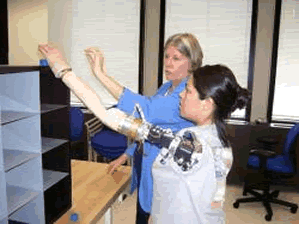Prosthetics.
The new age of machines
Journal Reference: The Lancet (vol 369, p 371)
Surgeons working on a female amputee in Chicago, US, have re-routed the ends of the motor nerves – which once controlled her arm’s movement – into the muscles in her chest and side. And the ends of the sensory nerves, which fed signals responding to heat and touch from her now-amputated arm to her brain, have been transferred to the skin on her chest.
Claudia Mitchell, shown on the right, a 26-year-old former US marine, is already able to control her prosthetic arm with more skill than is possible with conventional devices. She can carry out simple tasks intuitively, such as cutting up food, and at four times the speed of someone with a conventional prosthesis. And she has regained the sensation of having her arm touched when someone touches the patch of skin on her chest.

To make the process more intuitive, Todd Kuiken and colleagues at the Rehabilitation Institute of Chicago developed a technique called "targeted muscle reinnervation". Motor nerves that once controlled the arm are transferred to nearby muscles, which are then fitted with myoelectric sensors to detect contraction.
"When the person imagines closing their hand, the signal goes down the nerve. Then we use that signal to control the prosthetic hand," explains prostheticist Laura Miller.
Three amputees have previously had their motor nerves redirected in this way, and are able to control their prosthetic arms much more effectively than conventional devices.
In one of these patients, sensory nerves that once fed from the arm grew into the skin nearby. So for Mitchell, who lost her arm in a motorcycle accident, the researchers decided to help this process along, and redirected the sensory nerves into the skin of her chest.
The procedure was a success. Touch certain points on the patient's upper chest and she feels sensations as if from different fingers of her missing hand. She can even distinguish a range of pressures, temperatures and vibrations.
What did the researchers do to allow the brain to interact with the artificial limb?
What happens when the person thinks about moving their hand?
How do modern prosthetic arms currently on the market work?
How did the researchers allow Claudia Mitchell to experience sensations of pressure, heat and vibrations in her prosthetic arm?
What does this mean for people with paralysis?